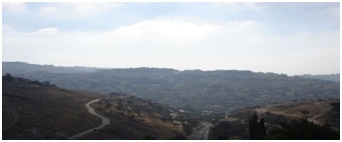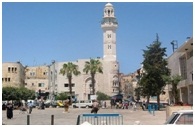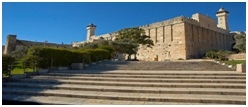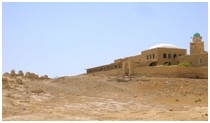Jerusalem (The Blessed Land)
“People are not to travel except to three mosques: The Sacred Mosque (in Makah),
Al-Aqsa Mosque (in Jerusalem), and my Mosque (in Medina).” (HADITH SHARIF)
Maimuna said: “O Messenger of Allah! Inform us about Bayt Al-Maqdis!” He said: “It
is the land where people will be gathered and resurrected [on the Day of Judgment].
Go (grammatically imperative!) and pray in it, for a prayer in it is the equivalent
of a thousand prayers in other [mosques].” I said: “What if I couldn’t reach it?”
He said: “Then you send a gift of oil to it in order to be lit in its lanterns,
for the one who does so is the same like the one who has been there. (HADITH SHARIF).
It is the religious duty of Muslims all over the world to maintain Al-Aqsa Mosque
both physically and spiritually
The Aqsa Mosque, in Arabic: Al-Masjid Al-Aqsa, literally means "the Farthest Mosque".
The sacred mosque is mentioned by name in the Holy Qur'an. It was the first Qibla
(the direction to which Muslims faced when offering prayers) before the revelation
from God of the new Qibla for prayers: toward the Ka'bah in the sacred City of Makah.
The Aqsa Mosque is also called the Farthest Mosque because it was place of worship
in the farthest west known to Arabs in the time of the Prophet Muhammad (peace be
upon him) and was sacred to both Jews and Christians. Historically, the Mosque was
originally built by Prophet Adam (peace be upon him). Prophet Ibrahim (peace be
upon him) rebuilt it. Prophet Daud (David - peace be upon him)
began the reconstruction which was completed by Sulayman (Solomon -peace be upon
him). The City of Jerusalem is Holy to Jews, Christians and Muslims world-wide as
it has their sacred sites.
Today the Aqsa Mosque is part of a large complex of religious buildings in Jerusalem's
old city known to the Muslims as al-Haram al-Sharif (Noble Sanctuary) and to the
Jews as the Temple Mount. For the Jews, the Temple Mount is the place where, according
to the Jewish belief, redemption will take place when the promised Messiah arrives.
There are also Christian sacred sites in Jerusalem including the Church of the Holy
Sepulchre - believed to be - the site of the crucifixion of Jesus Christ, the Church
of John the Baptist and other religious sites. The mosque was once a tourist site
but has been re designated purely a place of worship and learning for Muslims only
and closed to non-Muslims.
The City of Jerusalem and the Aqsa Mosque is sacred to all Muslims because its significance
is related directly to God, God's Holy Book: the Qur'an and God's Final Messenger:
Muhammad (peace be upon him). This is more than sufficient reason for every Muslim
to consider the City of Jerusalem and its Holy sites to be sacred, particularly
the Aqsa Mosque.
Further more, according to the basic Muslim belief the Holy Qur'an is the final
Word of God. Every word and every verse of the Qur'an is from the True God - Allah,
the Creator of the Heavens and the Earth. Therefore people who appreciate and follow
truth in their daily lives believe that the Qur'an is the highest authority and
the clearest guidance for mankind. Muslims take guidance from the Holy Qur'an, and
God has verified clearly the significance of Mi'raj (the Night Journey) of the final
Prophet Muhammad (peace be upon him) in the Qur'an. The Night Journey - one of the
most important events in the life of Muhammad (peace be upon him) - took place from
the Ka'bah in Makkah to the Farthest Mosque (Al-Aqsa) in Jerusalem.
Jerusalem is the holiest Islamic city after Makkah and Madina. Located in East of
this great city is Al-Haram al-Sharif (the Noble Sanctuary). The entire complex
is regarded as a mosque. In the middle is the Dome of the Rock, and glorious Al-Aqsa
Mosque is situated at its southernmost end. The Dome of the Rock was built in 687
AD by Caliph Abd al-Malik. The first wooden Al-Aqsa Mosque was constructed by the
Umayyads which completed in 710. The last major reconstruction was during 1035.
Al-Aqsa is the largest mosque in Jerusalem where approximately five thousand people
can worship in and around the mosque.
Al Aqsa Mosque
The site marks the spot where the Prophet Mohammad flew from Mecca to Jerusalem
on a journey the Koran describes as the furthest – thus the word Al Aqsa. The building
of the Mosque started under Abd El Malek and was completed by his son, Walid I.
In Arabic the Mosque is known as the El Haram esh-Sharif “the Noble Sanctuary
Al-Aqsa Mosque, where Messenger Muhammad (PBUH) led the prayers for the other messengers
The Aqsa Mosque is the only site in the world where all the Prophets performed Salah
prayer at one given time. It was here that the Prophet Muhammad (peace be upon him)
led the prophets in that very prayer during the night journey of al Isra and al
Mi'raj referred to in the Qur'an and hadith. It was from the Aqsa Mosque that the
Holy Prophet Muhammad (peace be upon him) ascended through the heavens visiting
the prophets again on his way to the Sidrat al-Muntaha (the Lote Tree) of the furthest
limit.
Since the miraculous Night Journey of Prophet Muhammad (Peace be upon him), al-Isra’
wa al-Mi`raj, took place more than fourteen centuries ago, Muslims have established
a sublime and perpetual relationship with Al-Aqsa Mosque. The Prophet was taken
from Al-Masjid Al-Haram in Mecca to Al-Masjid Al-Aqsa in Jerusalem. This event marked
a twining relation between the two mosques. The beginning of Surah Al-Isra’ (17:1)
reminds Muslims and non-Muslims of this important event.
We learn from the Holy Qur'an:-
"Glory be to Allah who did take His Servant for a journey by night from the Sacred
Mosque (in Makkah) to the Aqsa Mosque (in Jerusalem) the precincts of which We have
blessed, so that we might show hm some of our signs. Indeed Allah is the All-Hearing,
the All-Seeing." (The Holy Qur'an, Surah al-Isra).
The land around the Aqsa Mosque is referred to as the Blessed Land in the Holy Quran
(The Holy Qur'an, Surah 17:1)
Al-Haram al-Sharif has been a very important place of worship for the Muslims. Also
a great religious and educational centre throughout Islamic history for the Muslims,
the Jews and the Christians, attracting great teachers from all over the world,
The Islamic Waqf Foundation is in charge of the Aqsa Mosque, along with most of
the major mosques. The Haram al-Sharif is of very important religious and political
significance to Palestinians and to the Muslims around the world. Having the capital
in East Jerusalem is a fundamental element of Palestine.
The Dome of the Rock - where the Prophet Mohamed
(PBUH) ascended to heaven
The Dome of the Rock is one of the most beautiful shrines in the Islamic world.
It is a landmark of Jerusalem, Built originally by the Umayyad caliph Abdel Malek
in 691-2 AD. The site marks the spot where the Prophet Mohamed ascended to heaven
leaving his footprint in a stone within the Dome, which can be seen today.
Jerusalem the Land of the Prophets
Al-Tur - Jerusalem
This is the village of the Mount of Olives. Al-Tur is an ancient Palestinian village
with centuries of documented history and many archeological discoveries going back
to ancient times. As in Silwan, the earliest inhabitants are thought to be Canaanites.
The Mount of Olives offers the single best vantage point for panoramic views of
the entire city of Jerusalem. One of Al-Tur’s treasures is the Chapel of
the Ascension, a site which has always been the focal point of holy worship.
The Byzantines recognized this place as the location of Christ’s Ascension and built
the Elona Complex which included this first Chapel of the Ascension. The chapel
was originally built circa 350 A.D. Persian invaders later destroyed the chapel
in around 650 A.D. Later the chapel was rebuilt by the Crusaders in 1080. Salah
Edin (Saladin) converted the chapel to a mosque in 1198 and the structure has remained
unchanged ever since. It is thought that the chapel’s octagonal shape may have inspired
the design of the Dome of the Rock. Despite its ownership by the Muslim Waqf, the
chapel continues to be accessible by Christians. In fact, Christians Denominations
convene at the chapel once a year at Easter for Ascension Day and set up tents,
conducting worship services around the clock.
The Mount of Olives pulsates with church life, from the Pater Noster and Dominus
Flavit to the Church of All Nations, the Church of Mary Magdalene, and the Church
of Mary’s Tomb. An outstanding feature of the Mount of Olives lies at its base –
the Garden of Gethsemane and one of the best ways to approach the garden is to walk
down the hill from the Mount and into the Garden, seeing the Old City emerge at
different levels as you approach. Al-Tur’s churches share the neighborhood with
some of Jerusalem’s most prominent mosques which include the Khled Ibn Al-Walid
Mosque and the Salman Al-Farisi Mosque. Al-Tur is also the burial site of Mujir
Edin Alami, a renowned Arab scholar who wrote one of the seminal history texts of
Jerusalem.

Silwan - Jerusalem
Silwan is in a valley below the southern walls of the Old City and its character
is unique in that the old homes are built on steep cliffs. This village was built
on the first City of Jerusalem – the old Canaanite city that David conquered. Silwan
has a perennial spring called Ein Silwan, originating far beneath the Kidron Valley
and it wells up at Birket Al-Hamra. When David conquered the city, he was able to
do so in part by cutting the water supply, accessing
it from the spring’s tunnels which exist to this day, and forcing the Canaanites
to surrender.
Important discoveries of the tunnels were made by British archeologist Kathleen
Kenyon who conducted extensive excavations in this part of Jerusalem from 1961 to
1967. Highlights of a tour of Silwan should include a walk through the tunnels and
a meander through the Kidron Valley, stopping at the first century B.C. Tomb of
Absalom (or Tantour Firaoun) and the Tomb of Zachariah, associated with Saint James.
Roman and Byzantine excavations abound. Looking back at the Walls of the Old City
from Silwan offers unusual perspectives of the Al-Haram.

The Mosque of Omar Ibn al-Khattab - Jerusalem
The Old City of Jerusalem, as the point of convergence of the three monotheistic
religions of Judaism, Christianity and Islam has long been known as a flashpoint
of religious conflict. Yet the Mosque of Omar is linked to a surprising story of
peaceful coexistence between two of these religions that have warred over Jerusalem
for centuries. The Mosque of Omar commemorates the conquering Caliph Omar who in
638, came to the site of the Church of the Holy Sepulcher to pray to Jesus.
Having been invited into the Church to pray by the Patriarch Sophronius he refused,
saying, “If I had prayed in the church, it would have been lost to you, for the
Believers would have taken it out of your hands, saying ‘Omar prayed here’.” So
Omar prayed outside the Church and the story serves a cornerstone to the Mosque
which was to follow.
Built in the 12th century, the Mosque of Omar is neighbor to the giant Church of
the Holy Sepulcher, site of Christ’s entombment on which the first basilica was
consecrated in 335 AD. Over the ages, different structures have been built and destroyed
but the Church as it stands today is essentially the same building as consecrated
by the Crusaders in 1149. During the Crusader period, the Mosque of Omar was part
of a complex occupied by the Knights of St John, quartered nearby to protect Church.
For centuries the entrances to both Mosque and Church shared the same courtyard.
Later, during Ottoman period, a street-side entrance to the Mosque was opened to
accommodate worshippers.
The Mosque of Omar has two minarets whose tops are identical and although built
at different bases, are exactly the same height. It is thought that the line between
the minarets cancels out the dominance of the huge cross of the Church of the Holy
Sepulcher. The southern minaret is later than the Mosque’s first minaret, dating
from the Mamaluk period (15th century) but almost identical to its twin in the north.
There is no definitive information as to why the minarets of the same mosque as
so far from each other. Soon after the conquest of Jerusalem by Salah Edin (Saladin)
in 1187 AD, the care of the Mosque was entrusted to the Alami family who held the
Waqf (trust) Al Alami for centuries. The last Sheikh Al Alami is pictured in the
photograph above which hangs in his house next door to the Mosque. To this day,
access to the roof of the Church of the Holy Sepulcher is restricted by a complex
protocol providing different Christian denominations ownership and conditional access
to certain parts of the roof, with the Waqf having ownership of a portion as well
as its own privileged access. The roof is shown here in the photograph to right.
Maintaining the roof is the responsibility of the Waqf and at here at Jerusalem’s
heart, the roof remains one of the quiet refuges in the Old City, barely accessible
at all. Rebuilding and repairs are an integral part of the life of ancient buildings.
Both the Mosque of Omar and the Church of the Holy Sepulcher have each undergone
generations of modifications. Documents in the Alami family ordering repairs and
restoration to the mosques show that these undertakings have been commissioned as
far back as the 16th century.

Memorial Tomb of Raba’a Adwieh
Rabi’a al-‘Adawiyya from Basra was one of the most important founders of the mystical
element of Islam, known as Sufism. The stories about her life and teachings illustrate
a woman free from many of the traditional constraints placed on women’s lives. In
miracle stories such as this one, we see an essential element of Sufi thought: do
not expect anything from God, but rather, recognize the larger greatness of the
deity beyond your small existence.

Al-Haram al Ibrahimi - Hebron
Al-Haram al Ibrahimi al Khalil (The Sanctuary of Ibrahim, the friend) is a massive
mosque with a 20 meter high wall. The lower part dates from the time of Herod While
the main part was formerly a Crusader Church which was an enlargement of the original
Byzantine basilica used by Christian pilgrim en route to Abraham’s Oak at Mamre.
The upper part of four minarets (of which two remain) were added by the Mameluks.
As the place of David’s anointment and the burial of patriarchs, the sanctuary is
regarded as holy to Muslim, Christians and Jews.
Hebron, one of the oldest cities in the world, is known in Arabic as "Al-Khalil
Al-Rahman" In English this means "The Beloved of God the Merciful".
From the outside, the Haram Al-Khalil looks more like a fortress than a place of
prayer, its windowless walls with towering minarets and crenellations look austere
and for boding, The Israel Defence Force (IDF) soldiers guarding each entrance,
and harassing anyone wishing to enter the mosque (including us), only magnify this
feeling. The IDF troops are there to prevent further atrocities like the one that
occurred in 1994 when, during Friday prayers, a Jewish terrorist, opened fire in
the mosque and killed 29 people. Israeli troops outside opened fire on the people
fleeing the carnage, making matters even worse. After this incident, the Haram was
closed for six months. When it re-opened, it was divided, one half for Muslim worshippers,
and the other half for Jews. It is still divided

Jericho (The Tomb of Nabi Musa)
Maqam Al-Nabi Musa: The tomb of Prophet Moses lies 8 km south west of Jericho just
off the main Jericho-Jerusalem road. It is a splendid example of early Islamic architecture
set in an awe-inspiring landscape. The mosque is considered holy because it houses
the grave of Moses according to local tradition (Moses is recognized by Muslims
as one of the great prophets of Islam). The tomb has been the site of an annual
pilgrimage festival or mawsim at least since the time of the Muslim leader Salah
Eddin (Saladin). Until 1947, Muslims celebrated
the week-long Nabi Musa festival every spring here. The huge cemetery outside the
walls of Nabi Musa is reserved for Muslim pilgrims who died here During the festivals
or those who asked to be buried here because of the sanctity of the site. Jericho
is a green oasis in the Jordan Valley some 30 km east of Jerusalem, 7 km west of
the River Jordan, and 10 km north of the Dead Sea. It lies 250 meters below sea
level and is considered to be the lowest city in the world. Jericho is also the
oldest city in the world with some of the ruins discovered in the city being 10,000
years old. Besides its tourist sites, Jericho is an important area for agriculture
and is famous for its citrus fruits, dates, bananas, flowers and winter vegetables.
The city is also home to two refugee camps (Aqabat Jaber and Ein Sultan Refugee
Camps) and the further Jericho district several Israeli settlements have been built,
mostly on land confiscated from the Palestinian owners.
Islam recognizes the fact that the Holy Land is sacred to the People of the Book.
When Muslims say that the Holy Land is the
“Land of the Prophets”, certainly
the prophets of the Children of Israel are included and constitute a continuum in
the line of prophecy, which culminated with Prophet Muhammad (Peace be upon them
all). Almost every prophet lived in the Holy Land, or had a special relationship
with it, including those who were born elsewhere. An example of the latter is Prophet
Abraham, the prototype iconoclast. After he destroyed and mocked the idols of his
people, they planned violence against him, but he was destined to go to the Holy
Land. The following verse uses inclusive language to reflect the nature of Abraham’s
new home:
But we delivered him and [his nephew] Lot [and directed them] to the land which
we have blessed for the nations. Qur’an, 21: 71